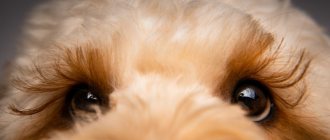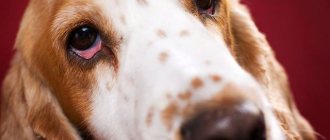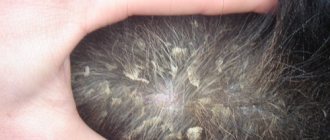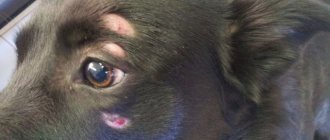Almost every veterinary specialist knows that an animal’s eyes are a “mirror” by which a specialist can visually determine if the animal is sick or not. Today in medicine, many human diseases are diagnosed by the eyes. Eye diseases in our dogs are quite common today. If you do not take the necessary treatment measures in a timely manner, sometimes your pet’s disease can result in loss of vision. A dog's eye is an organ specially adapted for the animal to perceive light waves. With the help of vision, your dog navigates the world around him, perceives the intensity of light, color, shape of objects, distance to them, as well as the movement of objects in space. With the help of vision, a dog in the wild gets its food, has the ability to move in the direction it needs, and defend itself in the event of an attack. Eye disease can lead to partial or complete loss of vision.
In everyday life, dog owners often notice watery eyes and sometimes pus in their dog's eyes. Unfortunately, dog owners are not always alarmed when they see that their dog’s eyes are festering. It must be borne in mind that the discharge of yellowish or greenish exudate is one of the signs of many diseases in dogs. Having seen that a dog's eyes are festering, owners should immediately contact their veterinary clinic, since a dog's festering eyes can be one of the signs of an incipient serious illness.
In this article we will try to figure out why a dog’s eyes fester.
Pus in a dog's eyes can appear as a result of many reasons, let's look at the main ones.
Allergy
Allergies in dogs have become the most fashionable disease in recent years. Allergens in dogs can include household chemicals and damage to the skin by ectoparasites (fleas in dogs). Often, purulent eyes are a sign of food allergy (food allergy in animals), which is accompanied by itchy skin (itching in dogs) and scratching in dogs. Dog owners note hair loss, which is externally manifested by the appearance of bald spots on the skin, redness of certain areas of the skin (dermatitis in dogs). The dog's owners report lacrimation and purulent discharge from the eyes. Ear diseases, nasal discharge (runny nose in a dog), and an unpleasant odor coming from the dog (bad breath in a dog) appear. The dog constantly licks the anal area and its front paws, and certain areas of the skin become wet (in the armpits and other folds of the skin).
Among dog breeds, French bulldogs and American cocker spaniels are more susceptible to food allergies. At the same time, specialists from veterinary clinics note the greatest predisposition to food allergies in dogs that are light in color (fawn Labradors, dachshunds, molosses of light fawn shades).
Often an allergic reaction in a dog is accompanied by a number of other symptoms - swelling of the nose, lips, paw pads, the dog sneezes often and for a long time. Allergies in dogs can manifest with severe symptoms such as pulmonary edema (pulmonary edema in dogs), bronchospasm.
If a dog exhibits allergic symptoms, owners should immediately contact their veterinarian.
Symptoms
Clinical signs of ocular inflammation are difficult to miss:
- Constant squinting.
- Redness of the conjunctiva.
- Swelling.
- Excessive tearing.
- Mucous or purulent discharge.
- Clouding of the cornea and lens.
- Redness, crusts, scales along the edges of the eyelids.
- Sticking or loss of eyelashes.
- Itching.
If at least one alarming symptom appears, the dog should be shown to a veterinarian in order to carry out a differentiated diagnosis and prescribe the correct treatment.
Viral diseases of dogs
Pus in a dog's eyes (purulent conjunctivitis) almost always accompanies viral diseases of dogs. Delay in contacting a veterinary clinic is fraught with serious consequences for the dog, as a result of which your dog may die.
The most common viral diseases among dogs in Russia are canine distemper, infectious hepatitis, parvovirus enteritis in dogs, adenovirosis (canine adenovirus), influenza in dogs, bordetellosis in dogs and others.
Each of the viral diseases of dogs has its own characteristic signs, but there are also common signs characteristic of a viral infection of dogs - a sharp increase in body temperature occurs, the dog loses its appetite, coughing (cough in dogs), sneezing, heavy breathing, wheezing appears on the respiratory system. If the gastrointestinal tract is affected - vomiting (vomiting in dogs), loose stools (diarrhea in dogs).
In addition to the above viral diseases, there are a number of viruses that appear in dogs in a latent form and are diagnosed during laboratory tests. Clinically manifested in dogs - purulent discharge, cough, nasal discharge, after exercise.
Based on the above, dog owners should always promptly contact specialists for veterinary help.
When to contact a veterinarian
Advanced ophthalmological diseases can lead to blindness, so it is very important not to delay diagnosis if alarming signs occur. These include:
- pain on palpation of the eyeballs;
- swelling of the eyelids;
- squinting in bright light;
- scratching the muzzle and eyelids with paws, accompanied by plaintive whining;
- redness of mucous membranes;
- increased tearfulness, change in color and consistency of discharge;
- increase in temperature;
- prolonged apathy, deterioration or lack of appetite.
These symptoms are characteristic of allergies, viral infections, hormonal disorders and other pathologies. The exact cause of the malaise is determined only on the basis of tests. Depending on the results, the veterinarian will tell you how to wash the dog’s eye from pus and how to eliminate the root cause of the disease.
Dogs affected by chlamydia and mycoplasmosis are one of the causes of pus in the eyes
Once in a dog’s body, mycoplasmosis for the time being proceeds sluggishly, practically asymptomatically without showing anything. And usually the disease occurs with symptoms of damage to the organ that is affected by it. In dogs, mycoplasmosis is manifested by: respiratory diseases - rhinitis (runny nose in dogs), cough in dogs, pneumonia in dogs, eye damage - conjunctivitis with purulent or serous discharge. Diseases of the genitourinary system - nephritis, cystitis, vaginitis, urethritis, prostatitis. More details about mycoplasmosis in our article - mycoplasmosis in dogs.
Another dangerous disease for dogs and people is chlamydia. In cities, the source of chlamydia is birds (mainly pigeons), which are the main reservoir of chlamydia. City dogs have a greater chance of catching this type of chlamydia on city streets and parks while walking. Damage occurs to the respiratory system, eyes, liver, and nervous system, and chlamydial myocarditis develops. In 30% of dogs, symptoms of hepatosplenomegaly are recorded, and gastrointestinal tract damage occurs (vomiting, diarrhea). Considering that chlamydia is a zooanthroponosis, dogs with chlamydia are a potential source of infection for their owners, especially in large cities where dogs are kept in apartments. For people, the consequences of contracting chlamydia can be very serious: abortion, infertility, chronic diseases of the genital area, arthritis, conjunctivitis, etc. Taking this into account, outreach work should be carried out with pet owners, recommendations should be given on preventive vaccinations of dogs against chlamydia, and even if If a disease occurs, adherence to the strictest personal hygiene measures, thorough comprehensive treatment of the sick dog, conducting serological tests of the owners and all people in contact with the sick dog. Detailed information about chlamydia can be found in the article – chlamydia in dogs.
Pus in the eyes due to traumatic injury to the eye area
Dogs, being active animals, during walks, especially in wooded areas, while hunting, often receive injuries to their eyelids and corneas from tree branches, in conflicts with other dogs, cats, etc. When a minor injury sustained by a dog is fresh, you can always purchase medicinal substances that have a wound-healing effect at the pharmacy. As such medications we can recommend: Bars drops, Iris, Dezatsid, Lacrimin aseptic, Mizofen ointment, Levomycetin drops, etc.
If a dog receives serious injuries in the eye area or head bruises, owners urgently need to conduct a thorough clinical examination of the animal. At the veterinary clinic, the injured dog will be provided with appropriate medical care.
List of drugs for treatment (drops, ointments)
To cure a sore eye, you need to apply a regimen that includes antibacterial, anti-inflammatory, and antibiotic drugs. In addition, if the pet is in severe pain, he is prescribed a pain reliever. In case of fever - antipyretic.
A new invention is an eye film that is inserted into the eye with tweezers. It has an antiseptic and antibiotic effect without causing discomfort to the dog. It dissolves on its own, no need to take it out.
| Purpose | Name | Price (rubles) | Mode of application |
| Antibiotics | Misofen | 215 (75 g) | Ointments are applied to the lower eyelid and distributed over the membrane 5 times a day (7-10 days) |
| Conjunctivin | 115 (3.5 g) | ||
| Tetracycline ointment (3%) | 150 (15 g) | ||
| Chlortetracycline ointment | 150 (30 g) | ||
| Optimmune | 2000 (3.5 g) | ||
| Anti-inflammatory drops | "Leopard" | 160-200 | 4 times a day, 3-4 drops into the sore eye until completely cured |
| Tsiprovet | 240 | ||
| "Iris" | 200 | ||
| Cyflodex | 220 | ||
| Conjunctivitis | 250 | ||
| Local antispasmodics | Novocaine | 50 (10 ml) | 2% solution, 3 drops 1 time per day for 5 days |
| Lidocaine | 30-40 (10 ml) | ||
| Antipyretics | "Carprofen" | 400 (20 tablets) | 2-4 mg per 1 kg of dog weight (dose for 2 doses), up to 14 days |
Tearfulness and pus due to corneal irritation
Tearfulness and pus in the corners of a dog’s eyes can occur as a result of exposure to caustic volatile substances on the cornea and mucous membranes of the eyes. Dogs are very sensitive to household chemicals containing chlorine-containing substances, to alcohol, turpentine and other volatile substances when, as a result of evaporation, contact of these substances with the cornea and conjunctival mucosa occurs. In the case when this contact in a dog is rare, the dog reacts with lacrimation as a protective reaction of the body; with constant contact, the dog develops purulent conjunctivitis and pus appears in the corners of the eyes.
Sometimes the cause of purulent conjunctivitis in a dog can be long hair on the animal’s face (lapdogs, poodles, fox terriers, etc.) constantly in contact with the mucous membrane and cornea of the eyes (eye diseases in dogs). Purulent conjunctivitis in a dog can cause particles of dust, sand and smoke to enter the conjunctiva.
Red squirrels
There may be three reasons why a pug’s eyes may be red:
Conjunctivitis
An inflammatory process caused by pathogenic bacteria or viruses entering the mucous membrane. With bacterial conjunctivitis, the eye becomes red and purulent discharge appears; with viral conjunctivitis, slight clear mucus appears.
Bacterial damage to the organs of vision should be treated with antibacterial drops and ointments. Perfect for this purpose:
- Tsiprolet;
- Phloxal;
- Levomycetin (drops);
- Tetracycline (ointment).
In case of a viral infection, it is enough to rinse the eyes with saline. solution until improvement occurs. If after 5 days of intensive treatment there is no improvement, be sure to visit a veterinarian.
Keratitis
With keratitis, redness of the eyes is accompanied by attacks of photophobia. The dog constantly closes its eyes in the light, and sometimes cannot open its eyelids at all.
Reference! In pugs, keratitis develops due to the growth of the nasal fold. Increasing in size, it begins to touch and damage the cornea of the eye.
In the early stages, the disease can be treated with medication under the supervision of a doctor. As it progresses, keratitis can lead to loss of vision or the vital need for surgical removal of the eye.
Entropy
Entropy is a disease caused by the appearance of an extra fold on the eyelid (most often the upper one). The eyelashes curl inward and put pressure on the eyeball. The disease can be detected only at six months of age and later. In particularly difficult cases, the problem is solved by surgical shortening of the eyelid.
Parasitic diseases - the cause of pus in the eyes
Dogs can be parasitized by a wide variety of parasites, both internal and external - worms (worms in dogs), fleas (fleas in dogs), ticks (ticks in dogs), as a result of whose vital activity one of the symptoms can be pus in the eyes. Ectoparasites often provoke an allergic reaction in dogs when they come into contact with the eyes; in case of dog ear mites (ear diseases in dogs), when scratching the ears, a dog can inadvertently damage the eye with its claws. As a result, pus appears in the eyes.
Formation of pus in the eyes as a result of chronic diseases
Among the reasons that often contribute to the formation of pus in a dog’s eyes are blockage of the lacrimal canal, congenital or traumatic ectropion of the eyelid, and diseases of the internal organs.
To establish the cause of the formation of pus in the eyes of a dog, sometimes it is necessary to conduct a thorough comprehensive examination of the animal in a veterinary clinic by conducting a general blood test, ultrasound of internal organs, fluoroscopy, etc. Conducting these studies is especially important for older dogs, when the immune system weakens. In aging dogs, veterinary specialists often find certain chronic diseases of the gastrointestinal tract, genitourinary system and kidneys.
How is the diagnosis carried out?
If an attempt to provide help to an animal at home does not produce results, it is important to demand from the veterinarian, whom in this case you need to contact, not to prescribe local medications (usually antibiotics or antiseptics), but to determine the exact diagnosis of what caused the conjunctivitis. Sometimes, after talking with the owner of the animal and carefully examining the “patient,” the doctor can with a high degree of probability determine the cause of the pathology without additional laboratory tests and examinations, but this must be verified.
In particular, a test with irifrin (healthy and affected vessels react to the indicator differently) or a test with a cotton swab, which allows you to determine whether the conjunctiva moves on top of the vessels or moves with them, will help to distinguish superficial keratitis or a mild form of conjunctivitis from intraocular inflammation.
Did you know? A dog's viewing angle is 250 degrees, while a person's is only 140.
More in-depth diagnostic measures may include:
- measurement of intraocular pressure (establishment of conjunctival or episcleral hypermia);
- magnetic resonance imaging and brain biopsy (detection of signs of meningoencephalitis);
- intestinal biopsy;
- ultrasound examination of internal organs;
- cytological examination of conjunctival scrapings (if the allergic nature of the inflammation is suspected);
- laboratory tests of stool, blood, urine.
Hypovitaminosis A in a dog
Hypovitaminosis A - this disease occurs in dogs with a lack of vitamin A (retinol, axerophthol) in the body and is manifested by symptoms of growth retardation, development, decreased natural resistance and local immune defense, peeling of the epidermis and dermatitis, metaplasia and keratinization of the epithelium of the mucous membranes and glands, violation vision and reproductive function (pathology of reproduction in dogs).
The first sign of hypovitaminosis A is that owners note their dog’s weakened vision when evening approaches, conjunctivitis, and clouding of the cornea (eye diseases in dogs).
A lack of vitamin A (it is found, for example, in offal, vegetables (carrots, pumpkin), greens, eggs) often leads to eye problems - blurred vision, the development of inflammation of the mucous membrane of the eye - conjunctivitis. Dogs that do not have the opportunity to eat a varied diet often suffer from hypovitaminosis A (including if they eat low-quality economy-class food, which is poor in vitamins and nutrients).
What can a dog owner do if there is pus in the eyes at home?
- The first thing an owner can do for his dog is to wash the festering eye with a decoction of medicinal herbs, such as St. John's wort, chamomile, and calendula. For rinsing in their absence, you can use a solution of furatsillin, potassium permanganate.
- Eye rinsing is carried out using a cotton pad or swab moistened with a decoction or furacillin. Rinsing is carried out with a disk from the inner corner of the eye.
- When washing, strictly adhere to the following rule: each eye is treated with a separate swab.
- After treating the sore eye with a decoction, excess moisture should be blotted off with a dry cloth.
- After this, apply 1% tetracycline ointment to the inner surface of the eyelids. The technique for applying the ointment is as follows: the owner pulls back the lower eyelid of the dog’s diseased eye and puts the ointment there. After this, closing your eyelids, gently massage.
Fester
Suppuration and sticky yellow-green crusts on the eyes are a sign of conjunctivitis that has developed as a result of a staphylococcal or streptococcal infection.
In the initial stages, you can get rid of the disease yourself by washing with saline solution and instilling antibiotic eye drops (Levomycetin or Floxal). In the absence of drops, you can use tetracycline ointment.
The procedure must be repeated three times a day. If there is no improvement on day 5, contact your veterinarian. He will select more effective treatment methods for your pet.
Preventing the formation of pus in the eyes of a dog
Prevention of the formation of pus in gases in a dog should be based on preventing the causes that lead to the appearance of pus in the eyes.
- In order to prevent viral diseases, the dog must be regularly vaccinated against those diseases that are widespread in the region of residence. Due to the spread of rabies in populated areas of the Russian Federation, vaccination against rabies is strictly required.
- Regularly treat your dog for worms.
- Ensure adequate feeding of the dog and normal living conditions (basics of feeding dogs, golden rules of rational feeding of dogs, feeding puppies, feeding pregnant females, feeding lactating dogs, feeding aging dogs).
- If there is a lack of vitamin A in the diet, use preparations containing vitamin A (vitamins for dogs).
- Strive to ensure that during a walk the dog cannot get injured in the head area from its relatives, cats. Walk your dog, especially in populated areas, on a leash.
- If you receive an injury in the eye area, take timely measures to treat the injury.
- If a dog has long hair on its face, it must be trimmed periodically to prevent hair from getting into the eye and injuring it.
- Dogs with bulging eyes (lapdogs, poodles, pugs, Pekingese, Japanese Chins) should have their eyes treated daily using products such as “artificial tears.”
- Examine the dog's eyes daily and, if necessary, remove any exudate that accumulates in the eyes.
- At the first sign of eye disease in your dog, seek veterinary help from your veterinarian immediately.
Why did the spots appear?
If your pug has strange spots on its eyes, you should not hesitate to visit a doctor. The cause of the disease in most cases is pigmentous keratitis. Pugs are susceptible to this disease for a variety of reasons:
- turning of the eyelids;
- trichiasis;
- districhiasis;
- dry eye syndrome;
- lagophthalmos.
Pigmentous keratitis requires intensive treatment under medical supervision. If the disease is left to chance, the dog may go blind or lose an eyeball.











